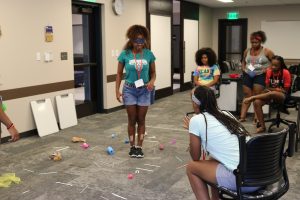Mine Field
Imagine navigating a space filled with objects you can’t step on. Now imagine the same task but without your eyesight. The only thing you have to guide you is a peer’s voice leading you through. Your peer can see the mine field ahead, and you must rely completely on their instructions to make it through the obstacle. Success would require a willingness to be vulnerable, an establishment of trust and effective communication. If this activity sounds like something that would be helpful for your group, read on to see how to do it!

Time Needed: 20-30 minutes
Group Size: Any
Materials: Masking tape, blindfolds, random assortment of supplies (this is for the mine field of obstacles – can be small toys, paper, pencils, plastic eggs, etc.)
 Directions: Prior to the start of the activity, make a start and finish line, approximately 12 feet apart, with the masking tape. Scatter the random assortment of materials around the room, between the start and finish lines. *Note: While you can use any materials for this, make sure they are small enough to step over to ensure a safe environment.
Directions: Prior to the start of the activity, make a start and finish line, approximately 12 feet apart, with the masking tape. Scatter the random assortment of materials around the room, between the start and finish lines. *Note: While you can use any materials for this, make sure they are small enough to step over to ensure a safe environment.
Split your group into partner pairs. If possible, partner individuals with someone they do not know well.
Partners will work together to get through the mine field of obstacles on the floor. One partner will need to be blindfolded or keep his/her eyes closed and will not be allowed to talk. The other partner is allowed to see and talk, but is not allowed to touch the other person. Have each pair decide which role they want to play and distribute blindfolds.
Explain that the goal is for each blindfolded person to get from one side of the space to the other. He/she must safely avoid touching the scattered materials by carefully listening to the verbal guidance of their partner. If someone touches an item, they have to start over.
Give each pair a few minutes of planning time. Then have blindfolded partner pairs (either one at a time or multiple depending on the group you’re working with) enter the area with the scattered materials. Remember, the blindfolded person can’t talk; he/she must just listen and walk. The guider can’t touch his/her partner but can speak to his/her partner. After a pair successfully reaches the other side, swap roles and repeat the process.
 Debrief Questions:
Debrief Questions:
- What was this experience like?
- How did it feel to touch an item and have to start over?
- For the person blindfolded, what was frustrating about not being able to talk or see?
- For the person guiding, how did you feel throughout the process?
- What roles do trust and communication play in this activity?
- How does this relate to challenges we may face when working on issues important to us in our community?
